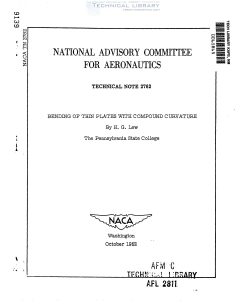naca-tn-2782
- Version
- 57 Downloads
- 1.04 MB File Size
- 1 File Count
- January 17, 2017 Create Date
- January 17, 2017 Last Updated
National Advisory Committee for Aeronautics, Technical Notes - Bending of Thin Plates with Compound Curvature

An analysis is presented for the deformation of a doubly curved
thin plate under edge loads or surface loads for small deflections.
This problem is approached from thin—shell theory so that the plate is
to form part of a shell of revolution. The method developed is particu—
larly useful for a plate whose radius of curvature in one direction is
large compared with its length and width dimensions. The solution con-
sists of an expansion about a parameter which depends on this fact.
An analytical solution is presented completely for a plate with an
arbitrary meridian curve of small curvature and loaded by normal edge
loads on one pair of opposite edges. Numerical calculations for the
deflection and moment distribution are presented for a particular
meridian curve. For the meridian curve chosen for the numerical example,
part of the surface had a negative Gaussian curvature. Results show that
the deflections and bending moment are largest at the part of the plate
with negative Gaussian curvature.
The method is developed to the point that it may be applied readily
to other problems of the deformations of doubly curved thin plates under
edge or surface loads. The theory, however, is limited to small deflec—
tions of the plate or shell considered.
This report is concerned with the behavior of a doubly curved thin
plate under edge loads or surface loads. This problem is considered in
the following way. The doubly curved plate is to form a part of a shell
of revolution bounded by two meridians and two parallels. The meridian
curve is assumed to have a radius of curvature much larger than the
radius of curvature of a parallel. This situation is clearly presented in
most airplane fuselage panels. The introduction of a small parameter
dependent on this fact'allows the equations for equilibrium of the shell
of revolution to reduce to ones with constant coefficients. The solution
of this sequence of problems then leads to a complete solution of the
problem. It may be noted that the method so developed is equally valid,
for analysis of the deformation of a shell 6f revolution with a meridian
curve of small curvature and loaded in any manner whatsoever.
| File | Action |
|---|---|
| naca-tn-2782 Bending of Thin Plates with Compound Curvature.pdf | Download |

Comment On This Post